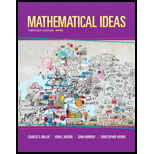
Concept explainers
(a)
To calculate: The initial rounded quota for the provided different state by use of Hamilton method if the total seats is 100 for 4 states and he table of population is given as,
(b)
To calculate: The initial rounded quota for provided different state by use of Jefferson method if the total seats is 100 for 4 states and he table of population is given as,
(c)
To calculate: The initial rounded quota for provided different state by use of Webster method if the total seats is 100 for 4 states and he table of population is given as,
(d)
To calculate: The initial rounded quota for provided different state by use of Huntington-Hill method if the total seats is 100 for 4 states and he table of population is given as,
Want to see the full answer?
Check out a sample textbook solution
Chapter 15 Solutions
Mathematical Ideas (13th Edition) - Standalone book
 Calculus For The Life SciencesCalculusISBN:9780321964038Author:GREENWELL, Raymond N., RITCHEY, Nathan P., Lial, Margaret L.Publisher:Pearson Addison Wesley,
Calculus For The Life SciencesCalculusISBN:9780321964038Author:GREENWELL, Raymond N., RITCHEY, Nathan P., Lial, Margaret L.Publisher:Pearson Addison Wesley, Holt Mcdougal Larson Pre-algebra: Student Edition...AlgebraISBN:9780547587776Author:HOLT MCDOUGALPublisher:HOLT MCDOUGAL
Holt Mcdougal Larson Pre-algebra: Student Edition...AlgebraISBN:9780547587776Author:HOLT MCDOUGALPublisher:HOLT MCDOUGAL

